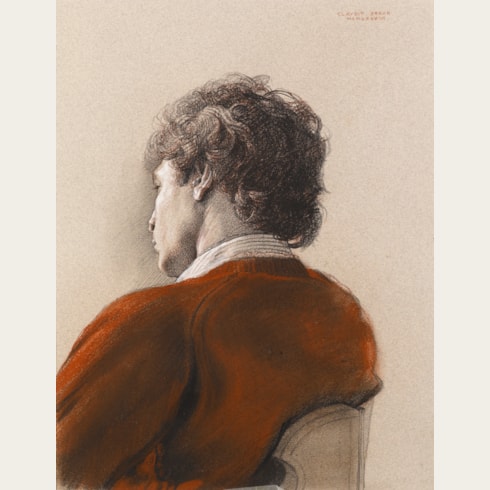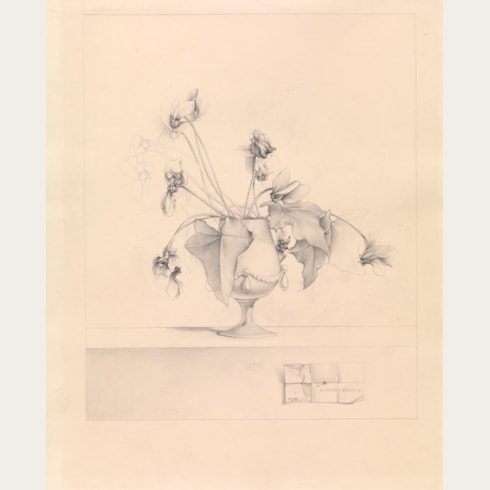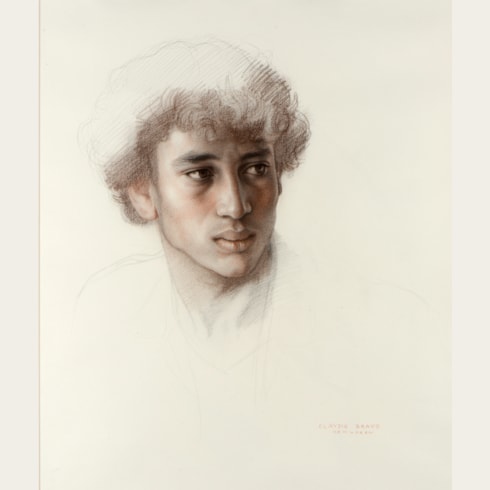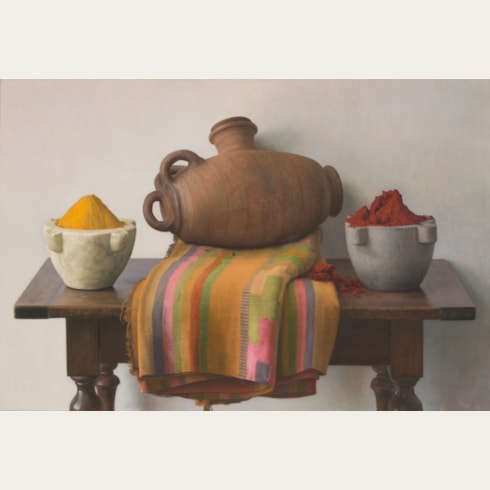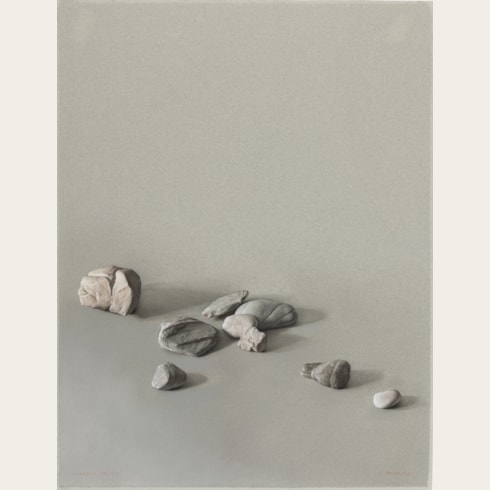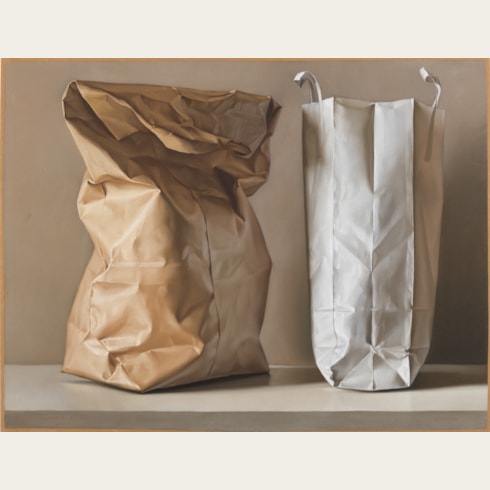Claudio BRAVO
(Valparaiso 1936 - Taroudant 2011)
Mystic Package
Sold
Chalk, conte crayon and pastel.
Signed CLAUDIO BRAVO in red chalk at the lower left and dated MCMLXVII in red chalk at the lower right.
750 x 1100 mm. (29 1/2 x 43 1/4 in.)
Signed CLAUDIO BRAVO in red chalk at the lower left and dated MCMLXVII in red chalk at the lower right.
750 x 1100 mm. (29 1/2 x 43 1/4 in.)
This very large pastel, drawn in 1967, can be grouped with a number of paintings, watercolours and pastels of wrapped packages, suggestive of canvases, loosely covered with paper and tied with string, that are among Claudio Bravo’s most compelling works. In particular, the present sheet is very similar to a large pastel White Package of the same year, in the collection of the Museum of Modern Art in New York. Other significant, large-scale pastels of the same motif from this period include Brown Package of 1967 in the Museo de Arte de Ponce in Puerto Rico, and the vertical Package of 1969 in the Baltimore Museum of Art. In Bravo’s first solo exhibition in New York, held at the Staempfli Gallery in December 1970, package paintings made up the majority of the twenty-two works on view.
As the artist later recalled of the genesis of the package paintings, ‘I suppose that the idea for these pictures came partly through looking at Mark Rothko’s paintings of large fields of color and partly through certain works that Antoni Tàpies had done using string across a canvas surface. The initial stimulus, however, was a very simple mundane one. Three of my sisters had come to stay with me from Chile. One day one of them came home with a number of packages and placed them on a table. I was fascinated by their forms and I painted them. I went on painting wrapped packages in many different ways, investigating the abstract possibilities of the forms while still creating recognizable objects.’ In another interview, Bravo recognized the enigmatic nature of these works, but added that ‘Yes, there’s some mystery in the wrapped packages, but what I really wanted to paint was the wrapping. I wanted to give a sense of trompe l’oeil tactility.’
In their simplicity and directness, Bravo’s wrapped packages of the late 1960s reflect the particular influence of the work of the Spanish Baroque painter Francisco de Zurbarán. As Bravo himself has acknowledged, ‘I use light a bit like Zurbarán did. He was one of the few painters that gave true transcendent meanings to objects. This treatment…makes things seem more than they are…their essence is greater.’ Soon after his move from Madrid to Tangier in 1972, Bravo decided to give up painting packages. One of his final paintings on this theme, dated 1972 and depicting a very similar wrapped white package to that seen here, is in a private collection in Chile. More than thirty years later, however, the artist returned briefly to the motif of wrapped packages, in several paintings executed in 2003 and 2004.
As the curator Sam Trower has noted, ‘There is something mysterious about all of Claudio Bravo’s art, but the package paintings are particularly compelling. An unknown object wrapped with beautifully folded and crumpled paper fills the entire surface of the painting…As with all great art, there is in these paintings something more, something intangible, almost spiritual, something as affecting as it is memorable. They are more than just beautiful paintings; their presence is overwhelming. In an art world where the art of painting oftentimes seems all but forgotten, the sheer sensuous beauty of Claudio Bravo’s wrapped packages reminds us of the pure pleasures of painting.’
Mystic Package was one of eighteen paintings and pastels of this distinctive subject shown in the exhibition Claudio Bravo: Wrapped Packages, held at the Bass Museum of Art in Miami Beach in 1997-1998. More recently, the present work was included in the exhibition Color into Line: Pastels from the Renaissance to the Present, held at the Fine Arts Museums of San Francisco in 2021-2022.
As the artist later recalled of the genesis of the package paintings, ‘I suppose that the idea for these pictures came partly through looking at Mark Rothko’s paintings of large fields of color and partly through certain works that Antoni Tàpies had done using string across a canvas surface. The initial stimulus, however, was a very simple mundane one. Three of my sisters had come to stay with me from Chile. One day one of them came home with a number of packages and placed them on a table. I was fascinated by their forms and I painted them. I went on painting wrapped packages in many different ways, investigating the abstract possibilities of the forms while still creating recognizable objects.’ In another interview, Bravo recognized the enigmatic nature of these works, but added that ‘Yes, there’s some mystery in the wrapped packages, but what I really wanted to paint was the wrapping. I wanted to give a sense of trompe l’oeil tactility.’
In their simplicity and directness, Bravo’s wrapped packages of the late 1960s reflect the particular influence of the work of the Spanish Baroque painter Francisco de Zurbarán. As Bravo himself has acknowledged, ‘I use light a bit like Zurbarán did. He was one of the few painters that gave true transcendent meanings to objects. This treatment…makes things seem more than they are…their essence is greater.’ Soon after his move from Madrid to Tangier in 1972, Bravo decided to give up painting packages. One of his final paintings on this theme, dated 1972 and depicting a very similar wrapped white package to that seen here, is in a private collection in Chile. More than thirty years later, however, the artist returned briefly to the motif of wrapped packages, in several paintings executed in 2003 and 2004.
As the curator Sam Trower has noted, ‘There is something mysterious about all of Claudio Bravo’s art, but the package paintings are particularly compelling. An unknown object wrapped with beautifully folded and crumpled paper fills the entire surface of the painting…As with all great art, there is in these paintings something more, something intangible, almost spiritual, something as affecting as it is memorable. They are more than just beautiful paintings; their presence is overwhelming. In an art world where the art of painting oftentimes seems all but forgotten, the sheer sensuous beauty of Claudio Bravo’s wrapped packages reminds us of the pure pleasures of painting.’
Mystic Package was one of eighteen paintings and pastels of this distinctive subject shown in the exhibition Claudio Bravo: Wrapped Packages, held at the Bass Museum of Art in Miami Beach in 1997-1998. More recently, the present work was included in the exhibition Color into Line: Pastels from the Renaissance to the Present, held at the Fine Arts Museums of San Francisco in 2021-2022.
Born in Valparaiso in Chile, Claudio Bravo received a Jesuit education in Santiago and there took art classes in the studio of the painter Miguel Venegas Cienfuentes, eventually deciding to become an artist himself. He had his first exhibition at the age of seventeen, and was soon much in demand as a portrait painter. In 1961, after several years living and working in Santiago and Concepción, Bravo left Chile for Europe. Settling in Madrid, he established a very successful career as a painter and society portraitist. In 1968 he spent six months working in the Philippines, and in 1970 had his first solo exhibition in New York. In 1972 he abandoned his busy life in Madrid for a large house and studio in Tangier in Morocco, where he began to focus on still life and landscape painting. Dividing his year between his studio in Tangier and another in Marrakech, as well as one in the far south of Chile, Bravo enjoyed a successful career until the end of his life. As one scholar noted, at the time of an exhibition of his work which toured four American museums in 1987 and 1988, ‘Claudio Bravo is one of the most significant artists working in a realist mode today. A painter and draftsman with a singularly fertile imagination, Bravo draws upon a myriad of sources in the art of the past and present, combining them in a uniquely personal manner.’
In 1994 a large exhibition of Bravo's paintings was mounted at the Museo Nacional de Bellas Artes in Santiago, Chile. Works by Claudio Bravo are in the collections of the Baltimore Museum of Art, the Ludwig Museum in Cologne, the Metropolitan Museum of Art and the Museum of Modern Art in New York, the Philadelphia Museum of Art, the Princeton University Art Museum, the Museum Boijmans-van Beuningen in Rotterdam, the Museo Nacional de Bellas Artes in Santiago and elsewhere.
Long recognized as a superb draughtsman, Bravo was a master of pencil, coloured chalks and pastel, which he applied with precision and delicacy.
Provenance
Alamillo Limited Collection, in 1997
Anonymous sale, New York, Sotheby’s, 27 May 2003, lot 11
Private collection, San Francisco.
Anonymous sale, New York, Sotheby’s, 27 May 2003, lot 11
Private collection, San Francisco.
Literature
Furio Rinaldi, Color into Line: Pastels from the Renaissance to the Present, exhibition catalogue, San Francisco, 2021-2022, no.72, illustrated pp.104-105.
Exhibition
Miami Beach, Bass Museum of Art, Claudio Bravo: Wrapped Packages, 1997-1998, no.6; San Francisco, Fine Arts Museums of San Francisco, Legion of Honor, Color into Line: Pastels from the Renaissance to the Present, 2021-2022, no.72.








